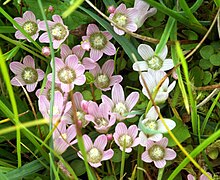
Anagallis arvensis, commonly known as the scarlet pimpernel, red pimpernel, red chickweed, poor man's barometer, poor man's weather-glass, shepherd's weather glass or shepherd's clock, is a species of low-growing annual plant with brightly coloured flowers, most often scarlet but also bright blue and sometimes pink. The native range of the species is Europe and Western Asia and North Africa. The species has been distributed widely by humans, either deliberately as an ornamental flower or accidentally. A. arvensis is now naturalised almost worldwide, with a range that encompasses the Americas, Central and East Asia, the Indian Subcontinent, Malesia, the Pacific Islands, Australasia and Southern Africa.

The Primulaceae, commonly known as the primrose family, are a family of herbaceous and woody flowering plants including some favourite garden plants and wildflowers. Most are perennial though some species, such as scarlet pimpernel, are annuals.

Cyclamen is a genus of 23 species of perennial flowering plants in the family Primulaceae. In English, it is known by the common names sowbread or swinebread. Cyclamen species are native to Europe and the Mediterranean Basin east to the Caucasus and Iran, with one species in Somalia. They grow from tubers and are valued for their flowers with upswept petals and variably patterned leaves.

Lysimachia is a genus consisting of 193 accepted species of flowering plants traditionally classified in the family Primulaceae. Based on a molecular phylogenetic study it was transferred to the family Myrsinaceae, before this family was later merged into the Primulaceae.
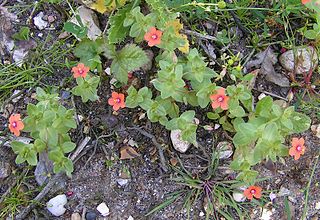
Anagallis is a genus of about 20–25 species of flowering plants in the family Primulaceae, commonly called pimpernel. The scarlet pimpernel referred to in literature is part of this genus. The botanical name is from the Greek ana and agállein, and it refers to the opening and closing of the flowers in response to environmental conditions.
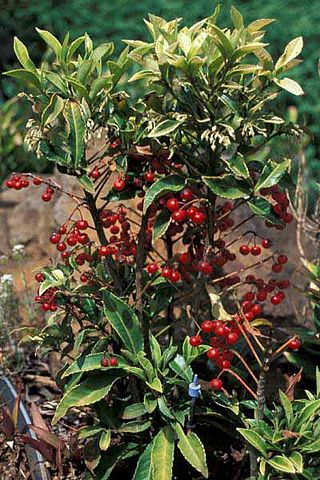
Myrsinoideae is a subfamily of the family Primulaceae in the order Ericales. It was formerly recognized as the family Myrsinaceae, or the myrsine family, consisting of 35 genera and about 1000 species. It is widespread in temperate to tropical climates extending north to Europe, Siberia, Japan, Mexico, and Florida, and south to New Zealand, South America, and South Africa.
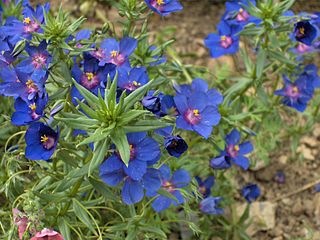
Lysimachia monelli, the blue pimpernel or garden pimpernel is a species of flowering plant in the family Primulaceae, native to the Mediterranean region. It is not to be confused with Lysimachia foemina, which has very similar blue flowers, but broader leaves and can be found also in colder climates. In a comparison of DNA sequences, L. monelli was shown to be most closely related to L. foemina. The latter had been thought by many to be closest to L. arvensis, and some authors had even included L. foemina as a subspecies of L. arvensis. The three species were among several transferred from Anagallis to Lysimachia in a 2009 paper.

Samolus is a widely distributed genus of about a dozen species of water-loving herbs. According to the APG III classification, this genus belongs to the family Primulaceae in the order Ericales. It was considered as closely related to a clade comprising the Theophrastaceae, and was treated as part of that family or in its own monogeneric family, the Samolaceae. The APG III system does not recognize these families and instead includes all genera formerly belonging to Theophrastaceae in the family Primulaceae.

Lysimachia maritima is a plant species belonging to the family Primulaceae. It was previously called Glaux maritima, the only species in the monotypic genus Glaux. The species has a number of common names, including sea milkwort, sea milkweed, and black saltwort.

Theophrastoideae is a small subfamily of flowering plants in the family Primulaceae. It was formerly recognized as a separate family Theophrastaceae. As previously circumscribed, the family consisted of eight genera and 95 species of trees or shrubs, native to tropical regions of the Americas.

Lysimachia vulgaris, the yellow loosestrife or garden loosestrife, is a species of herbaceous perennial flowering plant in the family Primulaceae. It was transferred to Myrsinoideae based on results of molecular phylogenetic research before being merged into the Primulaceae.

Lysimachia terrestris is a plant in the family Primulaceae.

Selaginella selaginoides is a non-flowering plant of the spikemoss genus Selaginella with a wide distribution around the Northern Hemisphere. It resembles a moss in appearance but is a vascular plant belonging to the division Lycopodiophyta. It has a number of common names including lesser clubmoss, club spikemoss, northern spikemoss, low spikemoss and prickly mountain-moss. This plant has one close relative, Selaginella deflexa, native to Hawaii. These two plants form a small clade that is sister to all other Selaginella species.
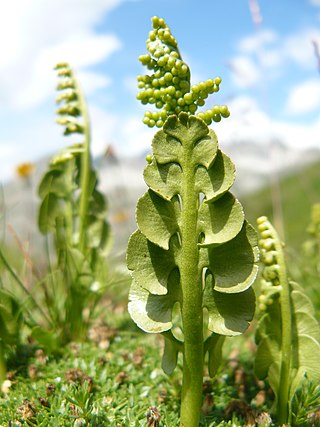
Botrychium lunaria is a species of fern in the family Ophioglossaceae known by the common name moonwort or common moonwort. It is the most widely distributed moonwort, growing throughout the Northern Hemisphere across Eurasia and from Alaska to Greenland, as well as temperate parts of the Southern Hemisphere.
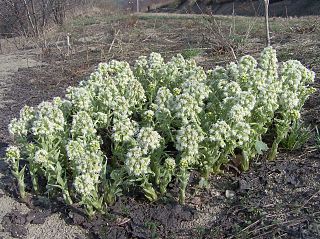
Petasites albus, the white butterbur, is a flowering plant species in the family Asteraceae. It is native to central Europe and the Caucasus.

Luzula pilosa is a species of flowering plant in the rush family Juncaceae with the common name hairy wood-rush. The plant is native to northern Europe and western Asia.

Lysimachia foemina is commonly known as blue pimpernel or poor man's weatherglass, and was formerly called Anagallis foemina. It is a low-growing annual herbaceous plant in the genus Lysimachia of the family Primulaceae. In a comparison of DNA sequences, L. foemina was shown to be most closely related to L. monelli. It had been thought by many to be closest to L. arvensis, and some authors had even included L. foemina as a subspecies of L. arvensis, as Anagallis arvensis subsp foemina. These three species were among several transferred from Anagallis to Lysimachia in a 2009 paper.

Lysimachia clethroides, the gooseneck loosestrife, is a species of flowering plant, traditionally classified in the family Primulaceae. It was transferred to the family Myrsinaceae based on a molecular phylogenetic study, but this family was later merged into the Primulaceae.
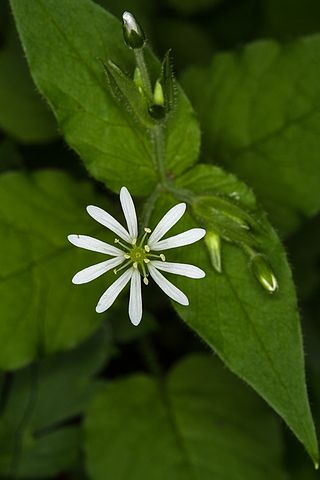
Stellaria nemorum, also known by the common name wood stitchwort, is a stoloniferous herbaceous perennial flowering plant in the family Caryophyllaceae.

Androsace laevigata, synonym Douglasia laevigata, known as the cliff dwarf primrose, is a species of flowering plant in the primrose family, Primulaceae. It is native to the central Pacific coastal mountains of North America below 2,400 metres (8,000 ft) elevation. Its habitat includes cliffs, rocks, and alpine.
